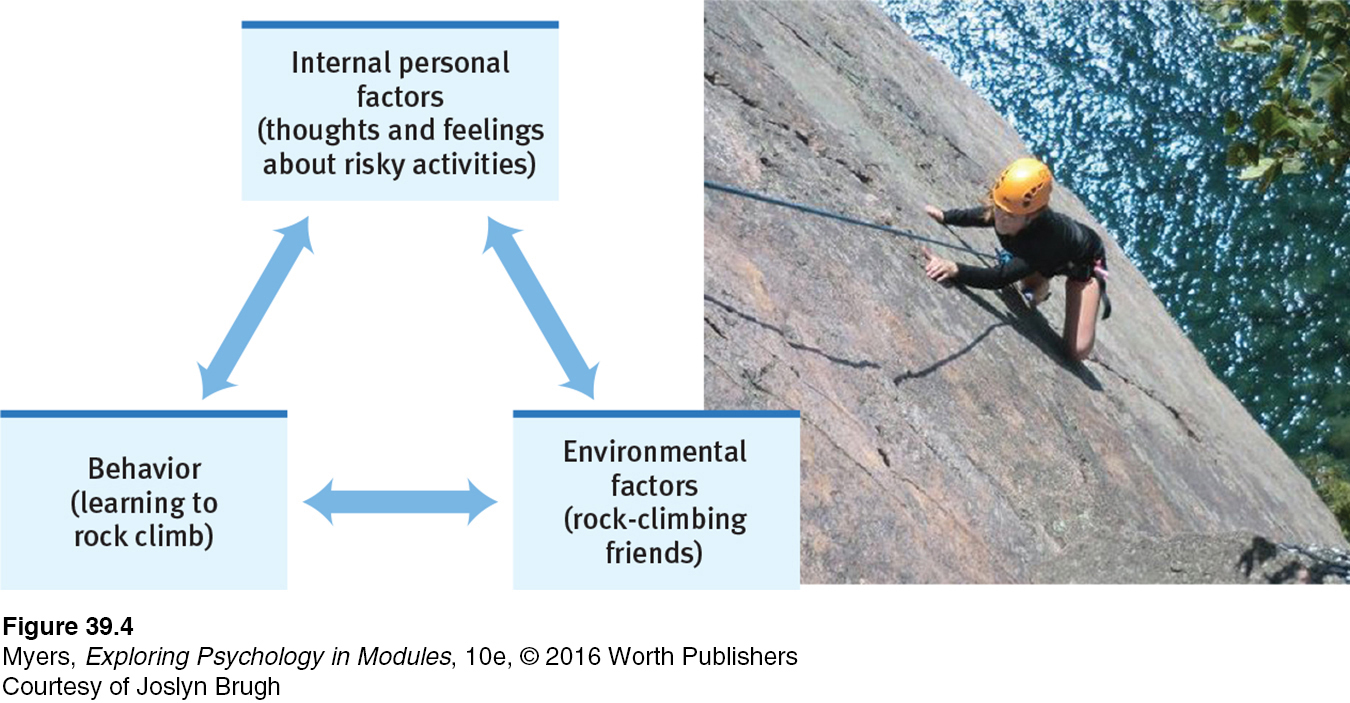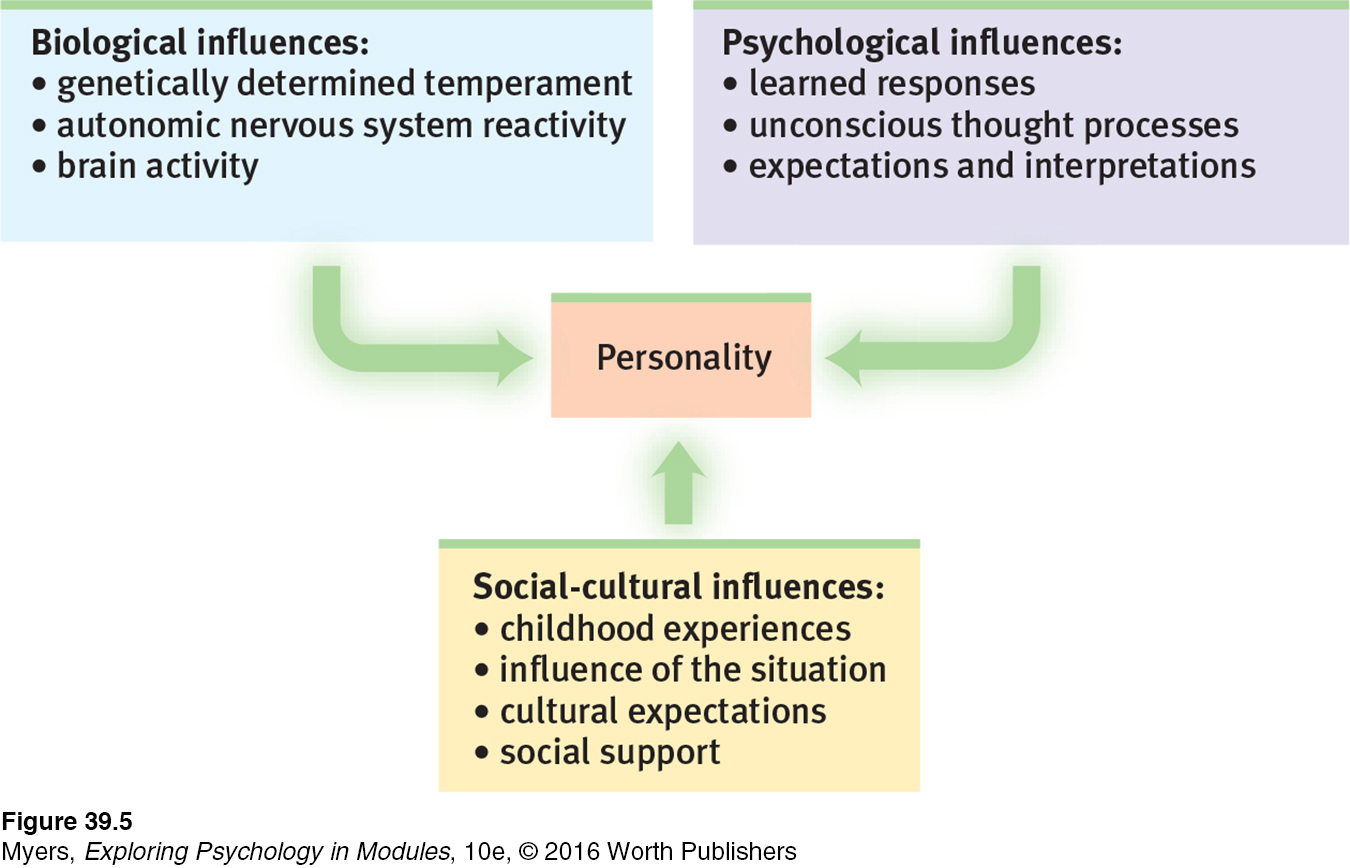39.2 Social-Cognitive Theories
39-
social-cognitive perspective views behavior as influenced by the interaction between people’s traits (including their thinking) and their social context.
The social-cognitive perspective on personality, proposed by Albert Bandura (1986, 2006, 2008), emphasizes the interaction of our traits with our situations. Much as nature and nurture always work together, so do individuals and their situations.
Social-
Reciprocal Influences
reciprocal determinism the interacting influences of behavior, internal cognition, and environment.
Bandura (1986, 2006) views the person-

Consider three specific ways in which individuals and environments interact:
Different people choose different environments. The schools we attend, the reading we do, the movies we watch, the music we listen to, the friends we associate with—
all are part of an environment we have chosen, based partly on our dispositions (Funder, 2009; Ickes et al., 1997). We choose our environment and it then shapes us. Our personalities shape how we interpret and react to events. Anxious people tend to attend and react strongly to relationship threats (Campbell & Marshall, 2011). If we perceive the world as threatening, we will watch for threats and be prepared to defend ourselves.
Our personalities help create situations to which we react. How we view and treat people influences how they then treat us. If we expect that others will not like us, our desperate attempts to seek their approval might cause them to reject us. Depressed people often engage in this excessive reassurance seeking, which may confirm their negative self-
views (Coyne, 1976a,b).
In addition to the interaction of internal personal factors, the environment, and our behaviors, we also experience gene-
In such ways, we are both the products and the architects of our environments: Behavior emerges from the interplay of external and internal influences. Boiling water turns an egg hard and a potato soft. A threatening environment turns one person into a hero, another into a scoundrel. Extraverts enjoy greater well-

RETRIEVE IT
Question
Albert Bandura proposed the - perspective on personality, which emphasizes the interaction of people with their environment. To describe the interacting influences of behavior, thoughts, and environment, he used the term .

Assessing Behavior in Situations
To predict behavior, social-
Military and educational organizations and many Fortune 500 companies have adopted assessment center strategies (Bray et al., 1991, 1997; Eurich et al., 2009). AT&T has observed prospective managers doing simulated managerial work. Many colleges assess students’ potential via internships and student teaching, and assess potential faculty members’ teaching abilities by observing them teach. Most American cities with populations of 50,000 or more have used assessment centers in evaluating police officers and firefighters (Lowry, 1997).
Assessment center exercises have some limitations. They are more revealing of visible dimensions, such as communication ability, than of others, such as inner achievement drive (Bowler & Woehr, 2006). Nevertheless, these procedures exploit a valid principle: The best means of predicting future behavior is neither a personality test nor an interviewer’s intuition; rather, it is the person’s past behavior patterns in similar situations (Lyons et al., 2011; Mischel, 1981; Schmidt & Hunter, 1998). As long as the situation and the person remain much the same, the best predictor of future job performance is past job performance; the best predictor of future grades is past grades; the best predictor of future aggressiveness is past aggressiveness. If you can’t check the person’s past behavior, the next best thing is to create an assessment situation that simulates the task so you can see how the person handles it (Lievens et al., 2009; Meriac et al., 2008).
“What’s past is prologue.”
William Shakespeare, The Tempest, 1611
Evaluating Social-Cognitive Theories
39-
Social-
Comparing the Major Personality Theories
| Personality Theory | Key Proponents | Assumptions | View of Personality | Personality Assessment Methods |
| Psychoanalytic | Freud | Emotional disorders spring from unconscious dynamics, such as unresolved sexual and other childhood conflicts, and fixation at various developmental stages. Defense mechanisms fend off anxiety. | Personality consists of pleasure- |
Free association, projective tests, dream analysis |
| Psychodynamic | Adler, Horney, Jung | The unconscious and conscious minds interact. Childhood experiences and defense mechanisms are important. | The dynamic interplay of conscious and unconscious motives and conflicts shape our personality. | Projective tests, therapy sessions |
| Humanistic | Rogers, Maslow | Rather than examining the struggles of sick people, it’s better to focus on the ways healthy people strive for self- |
If our basic human needs are met, people will strive toward self- |
Questionnaires, therapy sessions |
| Trait | Allport, Eysenck, McCrae, Costa | We have certain stable and enduring characteristics, influenced by genetic predispositions. | Scientific study of traits has isolated important dimensions of personality, such as the Big Five traits (conscientiousness, agreeableness, neuroticism, openness, and extraversion). | Personality inventories |
| Social- |
Bandura | Our traits and the social context interact to produce our behaviors. | Conditioning and observational learning interact with cognition to create behavior patterns. | Our behavior in one situation is best predicted by considering our past behavior in similar situations. |
Critics charge that social-
RETRIEVE IT
Question
What is the best way to predict a person's future behavior?